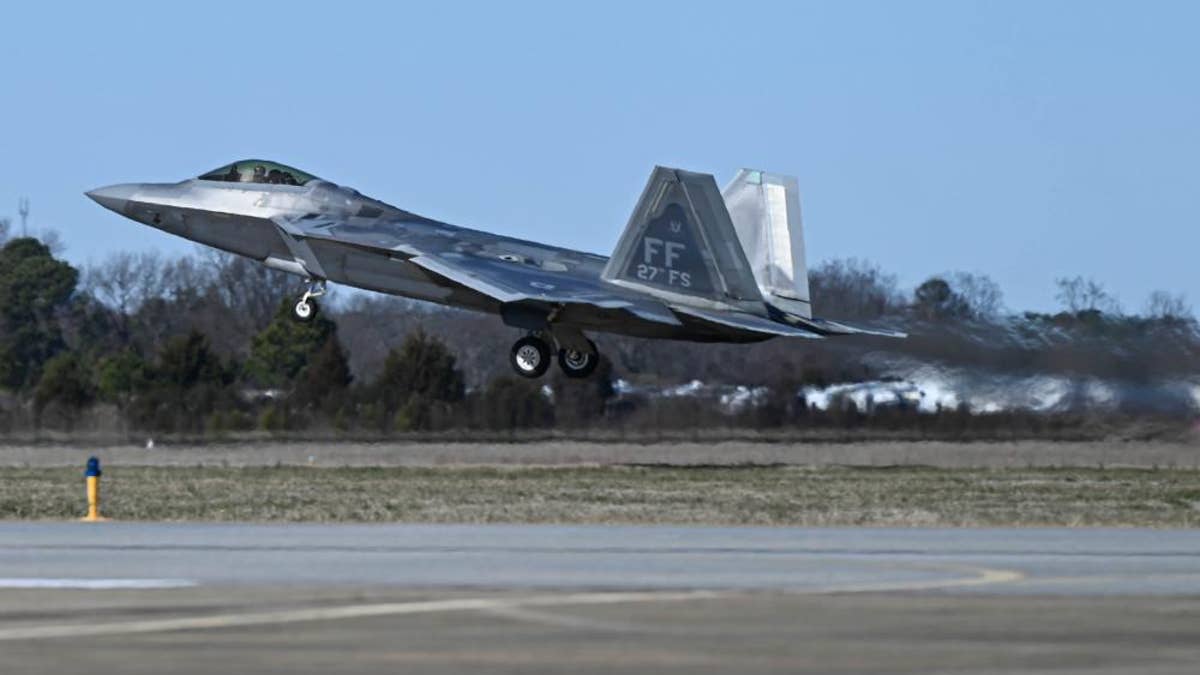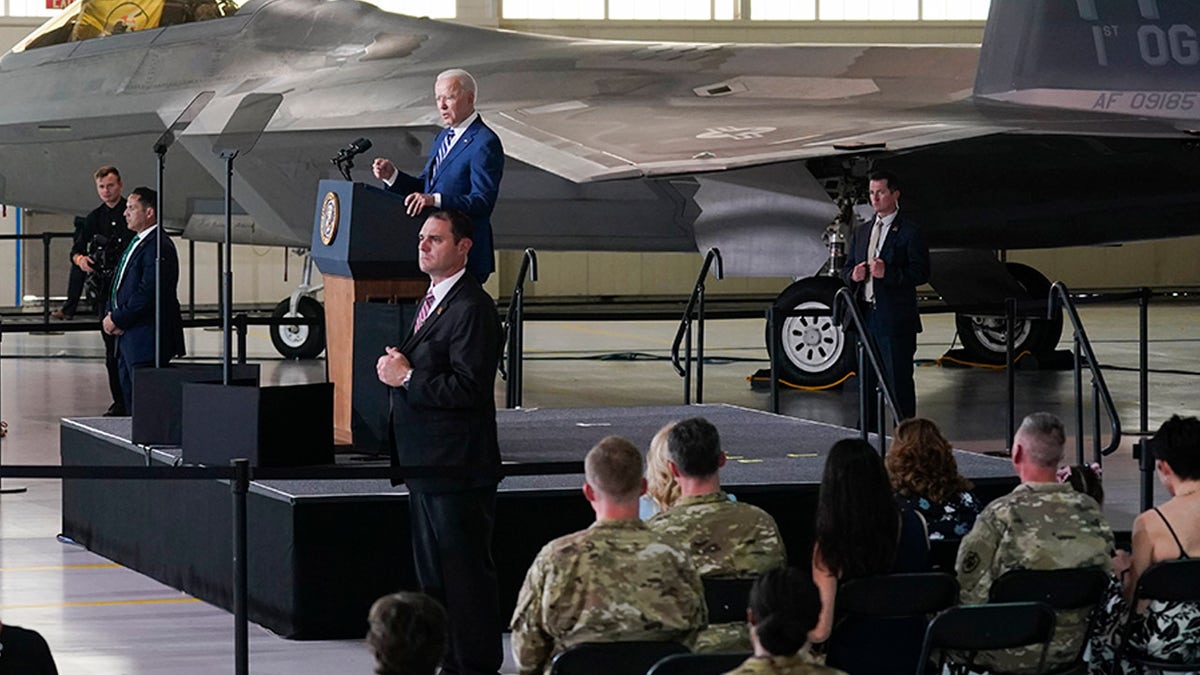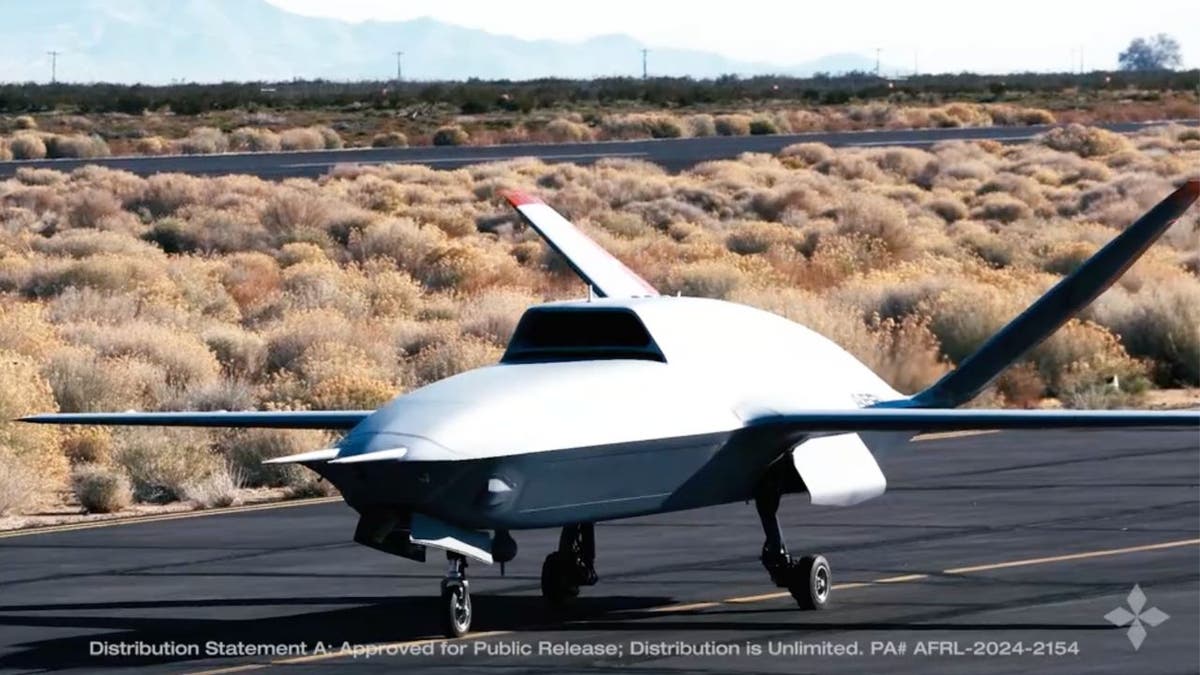New reporting about over a dozen unidentified drones that were allowed to fly over Langley Air Force Base has prompted fresh calls for change to a threat that experts say will only become more prevalent.
For more than two weeks in December 2023, the mystery drones traipsed into restricted airspace over the installation, home to key national security facilities and the F-22 Raptor stealth fighters.
Experts say the incident is likely one of many that U.S. authorities are underprepared to tackle in an evolving threat environment.
Lack of a standard protocol for such incursions left Langley officials unsure of what to do – other than allow the 20-foot-long drones to hover near their classified facilities.
The Pentagon has said little about the incidents other than to confirm they occurred after a Wall Street Journal report this month. Whether it knows where the drones came from or what they were doing is unclear.

An F-22 fighter jet takes off from Langley Air Force Base in Hampton, Virginia. (US NORCOM)
“I think they don’t know,” one congressional source familiar with defense operations told Fox News Digital.
UNKNOWN DRONE FLEET BREACHED US MILITARY BASE AIRSPACE IN VIRGINIA FOR 17 STRAIGHT DAYS: REPORT
As defense-minded lawmakers sought more answers, Langley officials referred them to the FBI, who referred them to Northern Command, who referred them to local law enforcement, the source said.
“They should easily be able to know exactly what they are,” said Brett Velicovich, an advisor to drone tech company Red Cat Holdings and a Fox News contributor.
“There are all kinds of radar systems out there. Each drone has its own fingerprint.”
“Saying we don’t know what it is, and if we’re taking them for their word that they don’t know what it is, that speaks to a larger issue that the administration really just got caught with its pants down, and they’ve failed.”
If the drones were a foreign adversary testing the limits of U.S. defenses, the message they took home is that encroaching on restricted airspace is easy enough, according to Velicovich.
U.S. capabilities offer many different ways to take down a drone, including shooting them, zapping them with heat lasers and jamming the frequencies.
Whether Congress needs to change the laws is a point of contention, but one thing that is clear is incursions like the one at Langley prompt confusion over legal authority.

President Biden speaks at Joint Base Langley-Eustis in Hampton, Virginia, the site of two weeks of unidentified drone incursions. (AP)
When drones encroach near bases overseas, the rules of engagement give service members more leeway to engage with them.
However, U.S. law does not allow the military to shoot down drones near its bases unless they pose an imminent threat. While Langley has the authority to protect its coastal base, the Coast Guard has the authority to protect the waters, the Federal Aviation Administration has authority over U.S. airspace – some of the most congested with commercial airliners in the world.
“After 9/11, we invested all this money in homeland security to deal with exactly the kind of things that we’re seeing today,” said James Carafano, defense expert at the Heritage Foundation. “We built this whole infrastructure to deal with that. And it just seems, where is it today? We’ve been very lackadaisical about this.”
“We’re going to have a terrorist attack here at some point. It’s just going to happen.”
Rep. Mike Rogers, R-Ala., chair of the House Armed Services Committee, argued that the Defense Department needs to use the authority it has been given.
“Drone incursions at DOD facilities are alarming. The Department needs to focus on deploying real, effective capabilities across critical installations using existing authorities given to them by Congress. I will continue to conduct oversight of the department’s response to these drone incursions,” he said in a statement.
Sen. Jerry Moran, R-Kansas, promised to introduce legislation to give the Pentagon greater authority to shoot down drones.
“Military leaders currently lack the authority to engage until there is an imminent threat posed to our men and women in uniform. I am working on legislation to provide the Department of Defense with the necessary authorities to engage drones or unidentified aircrafts that breach our military airspace before it is too late to respond.”
Mississippi Sen. Roger Wicker, the top Republican on the Senate Armed Services Committee, called for Congress to pass laws laying out counter-drone procedures.
“Adversaries like China, Russia and Iran are improving their drone capabilities every month. Our defenses are not catching up,” he said.
“Congress needs to develop and execute a comprehensive set of plans to strengthen our counter-drone protocol and technological development right away. There is no time to waste. The lives of service members and all Americans are at risk.”

US Air Force’s XQ-67A drone. (AFRL)
This month, Chinese national Fengyun Shi was sentenced to six months in prison for capturing drone footage over Huntington Ingalls Industries Shipbuilding in Newport News, Virginia, 10 miles from Langley Air Force Base.
Two months prior to Langley, in October 2023, five drones flew over the Energy Department’s Nevada National Security Site, used for nuclear weapons experiments. U.S. authorities were not sure who was behind those drones either.
A Chinese surveillance balloon traversed over the U.S. for a week last year before the Air Force shot it down off the coast.
US INVESTIGATING RELEASE OF CLASSIFIED DOCS ON ISRAEL’S PLANNED STRIKE ON IRAN
U.S. Air Force’s Plant 42 in California, home to highly classified aerospace development, has also seen a slew of unidentified drone incursions in 2024, prompting flight restrictions around the facility.
“There are a lot of regulations on terms of what the DoD is allowed to do in the U.S. homeland that make this a really difficult problem,” said Stacie Pettyjohn, director of the defense program at the Center for a New American Security.
Even jamming the GPS systems, so drones freeze up and fall out of the sky, risks collateral damage. It could interfere with nearby air traffic.
“Unlike when you’re in Iraq or somewhere and there are drones flying overhead, you can fire off a missile and intercept them without as much worry, because you’re in the middle of the desert,” he continuted. “We’re going to see more of this in the future, and I think it’s something that the U.S. is grossly underprepared for.”
Even abroad, experts warn U.S. forces are unequipped to handle the threat of advancing drone warfare.
CLICK HERE TO GET THE FOX NEWS APP
Three U.S. service members were killed in a drone strike in January in Jordan.
“The response time for [counter-drone measures] is really small, and the U.S. doesn’t have a lot of systems that are optimized for this, and they’re quite expensive,” said Pettyjohn. “We’re going to see more of these, probably larger groups operating together. Right now, they’re all remotely piloted. Eventually, they’ll be autonomous and really truly swarm.”
